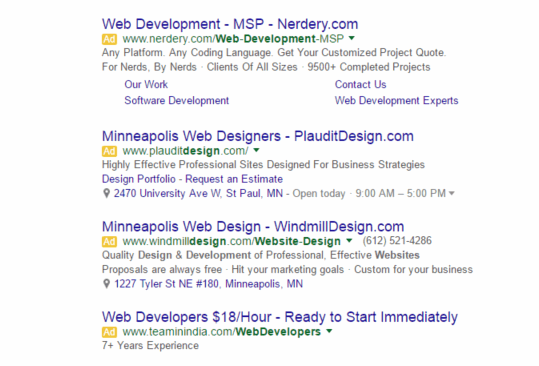SEM ad copy tips that you may find scary
Trying new things can sometimes be frightening for paid search marketers, but columnist Brett Middleton argues that leaving your comfort zone is the key to differentiating your brand and obtaining qualified traffic.

Writing ad copy for your AdWords campaign typically is a process that unfolds something like this:
- Identify keywords and user needs.
- Write copy that speaks to both.
- Make small tweaks and A/B test over time.
This is exactly how we end up with search results that look like this:
While these ads are not exactly the same, they’re similar enough to be more or less indistinguishable to the average searcher.
We are clearly creating problems for searchers with a process that leads to nearly identical search ads from every company. Consumers have no idea which resource is going to be the best for them.
Somewhere along the way, the process became more about getting all of the clicks rather than the right clicks. The result is that companies fail to differentiate themselves — and thus fail to attract the customers most likely to buy from them.
Here is what needs to be done to get SEM ad copy in a better place than where we find it today.
Search every time you write
Logging in to AdWords to check the recent performance of your ads, declaring a winner and making a new variation should not be done in a vacuum. Unfortunately, it’s extraordinarily easy to let this happen.
The process of A/B testing ad copy has, by necessity, become a very linear one in which we observe our own previous iterations and look for a new one that will provide better results than its predecessors; this is logical, but it is ultimately a flawed way to conduct our revisions. Without the context of real, live SERP results to inform our decisions, we lose out.
If I’m writing an ad for a web development company in Minneapolis, I would begin by performing the above search and seeing what I’m up against. After evaluating my competitors’ ad copy, here are a few tactics I could use.
Don’t use the keywords in your headline
Seriously. This isn’t a sabotage article trying to get you all to change your tactics and make my ads look better. It’s a serious recommendation.
The practice of keyword stuffing for organic traffic has fallen out of favor; it’s about time we paid search marketers get on board as well. Rather than including the keyword you’re targeting in both the headline and the ad copy, do something much more helpful to the searcher: answer a key question or describe defining aspects of the product or service you provide.
Relying on ad creative that doesn’t feature an explicit headline can feel like a terrible idea, because it’s outside of our comfort zone as paid search marketers. But by definition, A/B testing should include new material that hasn’t been seen in other variations by searchers to test for ideal performance.
Qualify searchers in your ad copy
The exact opposite of the approach you may be taking at this point, the choice to limit the number of clicks you receive on your ads, is absolutely something that will attract a fair amount of flak.
However, we use this exact mindset when conducting keyword research: focus on more specific, more targeted terms (rather than broader catch-all terms) in order to ensure qualified and relevant traffic. The fact that we fail to heed this same advice when constructing ads is a fundamental flaw of our SEM processes.
Keyword targeting and ad copy creation need to be treated similarly, instead of being viewed as entirely separate steps along the way to gaining a customer; we can begin this transition by viewing the A/B testing process the same as the transition from broad-match heavy traffic to phrase/exact-match keywords as traffic generators.
As you write variations of ad copy, begin to test (in one ad group; don’t go crazy and apply this everywhere) ad copy that addresses potential objections your sales team frequently receives with leads coming in.
For example, a run-of-the-mill ad for “Web Development Minneapolis” should be tested against ads that identify average price of a web build, project time, content management systems used and so on. Again, this is meant to do one thing: reduce the number of unqualified clicks coming in. CTR will drop, but so will cost per conversion, which is ultimately a much more important KPI.
Fail — we pretty much have to
Some of the above tactics may be things you have tested out before, or they may sound insane and destined to fail. But every ad we write fails at some point, and continuing to make small tweaks to the same ad structure — and failing to evolve the ideas and strategies behind them — is ultimately how we end up with six advertisers on page 1 of Google shouting the same message into the void while a searcher randomly chooses.
Ad position, usage of ad extensions and previous knowledge of a brand can all impact our success in SEM, but taking a chance could ultimately be the thing that transforms your campaigns from adequate to ridiculously good-looking. Take a chance.
Contributing authors are invited to create content for Search Engine Land and are chosen for their expertise and contribution to the search community. Our contributors work under the oversight of the editorial staff and contributions are checked for quality and relevance to our readers. The opinions they express are their own.
Related stories

